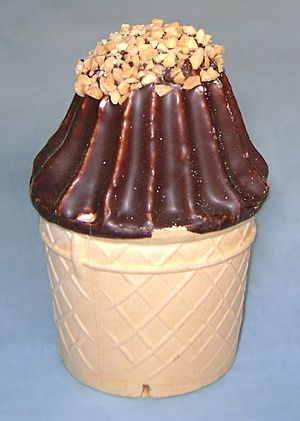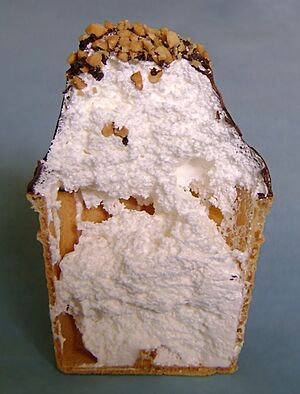Warm ice cream facts for kids

Ciepłe lody
|
|
| Alternative names | Ciepłe lody |
|---|---|
| Type | Cake |
| Course | Dessert |
| Place of origin | Poland |
| Serving temperature | Cold |
| Main ingredients | Waffle, mousse |
Warm ice cream (called ciepłe lody in Polish) is a unique dessert from Poland. It looks a lot like regular soft-serve ice cream. However, it's made from a light, fluffy foam, usually from egg whites. This foam is often topped with syrup, chocolate, or other yummy sauces. It's served in a waffle cup, just like an ice cream cone. Even though it's called "warm ice cream," it's actually served cold! It's a fairly inexpensive treat, but it does have a lot of calories.
What is Warm Ice Cream?
Warm ice cream is a sweet treat that might surprise you. It has a soft, airy texture, similar to a mousse. This dessert is placed inside a crispy waffle cup. The name "warm ice cream" comes from how it looks, not its temperature. It's a popular dessert in Poland and a fun twist on traditional ice cream.
A Bit of History
This interesting dessert became popular in Poland a long time ago. During the time of the Polish People's Republic (which was Poland's government from 1944 to 1989), food was sometimes hard to get. People had to be creative with what they had. The Polish weekly magazine Wprost says that warm ice cream was created during this time. It was one of many "ersatz foods," which means they were substitute foods. These were made to replace things that were scarce or expensive, like Polo-Cockta replaced Coca-Cola. Today, warm ice cream is still enjoyed. It's part of what people call "PRL nostalgia," which is a fondness for things from that earlier time in Poland's history.
Similar Treats Around the World
Warm ice cream isn't the only dessert that looks like ice cream but isn't quite. There are other similar treats in different countries. For example, in Germany, they have Schokoküsse. In Denmark, you might find Flødeboller. And in Israel, there's a popular treat called Krembo. These are all types of chocolate-coated marshmallow treats. They were sometimes also called "warm ice cream" in Poland because they shared a similar look and feel.
In Hungary, there's a dessert called télifagyi, which means "winter ice cream." It's very similar to warm ice cream. This Hungarian treat also became very popular during the time of Communism in that country. Even today, you can still find télifagyi widely available in Hungary.


